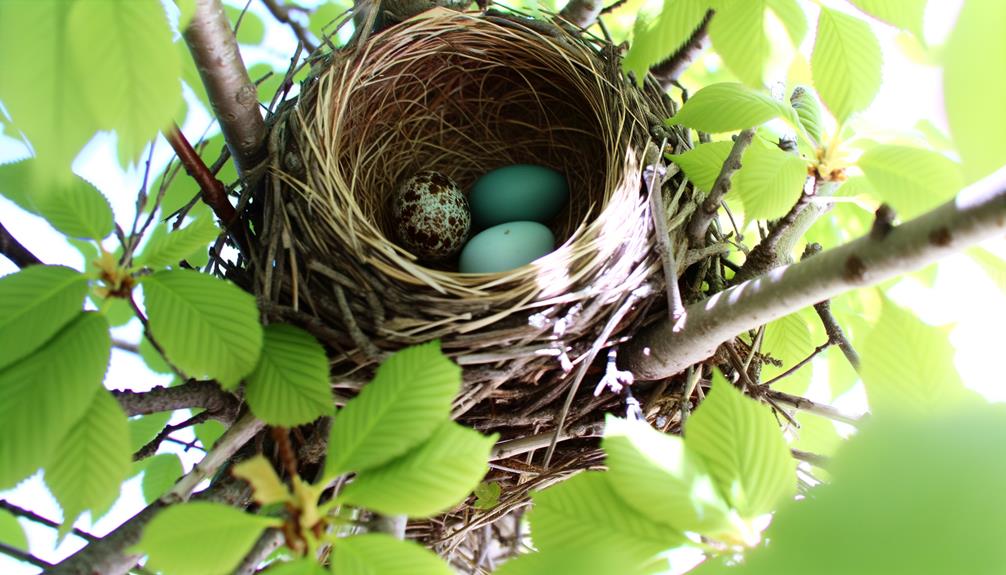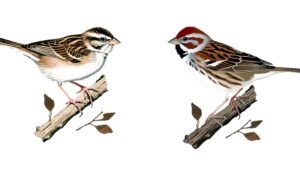5 Ways to Compare Robin and Chipping Sparrow Eggs
Robin and Chipping Sparrow eggs have significant differences. Robin eggs are a vibrant blue, oval-shaped, larger, around 1.1 inches in length, and their blue hue comes from the biliverdin pigment.
Comparatively, Chipping Sparrow eggs are smaller, roughly 0.8 inches in length, and spherical with slight tapering. Their coloration is a light bluish to greenish white with occasional speckling.
Both respective colors and patterns are influenced by various genetic and environmental factors. Understanding these differences offers compelling insight into their distinct survival strategies and species adaptations, aspects that intensify as one explores further.

Key Takeaways
- Robin eggs are vibrant blue and oval-shaped, while Chipping Sparrow eggs are white with brown spots and slightly elongated.
- The average size of Robin's egg is larger (2.2 cm length, 1.6 cm diameter) compared to a Chipping Sparrow's (0.8 inch length, 0.6 inch width).
- Both Robin and Chipping Sparrow egg appearances are influenced by diet, environment, and genetics.
- Robins have a slightly longer incubation period of 14 days compared to Chipping Sparrows' 12 days.
- Both species exhibit unique survival strategies and parental vigilance related to their egg characteristics and nest placements.
Understanding Bird Egg Basics
To fully understand the differences between Robin and Chipping Sparrow eggs, it's crucial to first grasp the fundamental characteristics that define bird eggs. Their structure, color, and size are key identifiers.
All bird eggs have a tough, protective shell, typically composed of calcite crystals. This shell is semi-permeable, allowing gas exchange while preventing water loss. Egg size varies greatly; larger birds often lay larger eggs.
Coloration is another crucial aspect. While some bird eggs are plain, others exhibit speckles, spots, or streaks. These patterns can assist in camouflage or signal quality to potential mates.
Identifying Robin Eggs
In identifying Robin eggs, several characteristics are pivotal: coloration, size, and the incubation period.
The unique hue of Robin eggs provides a visual marker, while their size offers an additional dimension for identification.
The incubation period, conversely, provides temporal insight into the species' reproductive cycle.
Robin Egg Coloration
One can easily identify a robin's egg by its distinctive coloration, typically a vibrant, unmarked blue. This coloration isn't accidental but rather a result of biliverdin, a pigment deposited on the eggshell during the laying process.
It's worth mentioning that the intensity of this blue hue can vary among individual robins and geographic locations. Some theories suggest that this fluctuation in color intensity may reflect the female's health or stress levels during egg formation. However, the exact reason behind this variation remains a subject of ongoing scientific investigation.
Interestingly, not all robin eggs are blue – a smaller percentage may be white or lightly speckled. These exceptions are typically linked to genetic factors or dietary influences, thereby adding another layer of complexity to robin egg coloration.
Size of Robin Eggs
Moving beyond color, the size of a robin's egg also provides essential clues for identification, typically measuring about 1.1 inches in length and 0.8 inches in diameter. This fairly consistent size, larger than many other bird species, is a key identifier, helping to differentiate robin eggs from those of similar species like the chipping sparrow.
The egg's oval shape, with one end slightly narrower than the other, is an additional distinctive feature. The size and shape of robin eggs are the result of evolutionary adaptations, enabling them to fit snugly into the nest, minimizing the risk of falling out.
It's notable that while these measurements are averages, slight variations can occur, depending on the individual bird's age and health. Therefore, size serves as a reliable, albeit not infallible, identification tool.
Robin Egg Incubation Period
Beyond size and color, the incubation period of robin eggs offers another distinguishing characteristic that aids in their identification. The incubation period is typically 12-14 days, a duration that is relatively shorter compared to some other bird species. During this time, the female robin remains steadfast, leaving the nest only briefly for sustenance.
To better understand this, let's visualize the incubation period in a markdown table:
| Bird Species | Egg Color | Incubation Period |
|---|---|---|
| Robin | Blue | 12-14 days |
| Sparrow | White | 10-15 days |
| Canary | White | 13-14 days |
You'll notice from the table that although the egg color varies, the incubation periods for these bird species are quite similar, underscoring the complexity of avian reproductive biology.
Robin Egg Size and Shape
When evaluating the size and shape of robin eggs, one must first consider the dimensions. The average size, regarding both length and breadth, provides an essential starting point for understanding the overall physical characteristics of these eggs.
Moreover, identifying shape traits and exploring the size variation within the species will provide a thorough view of the robin eggs' distinctive attributes.
Robin Egg Dimensions
Delving into the dimensions of a Robin's egg, one finds that they typically measure around 2.2 cm in length and 1.6 cm in diameter, exhibiting a somewhat oblong shape with a smooth, glossy finish.
These dimensions, while somewhat standard, can vary slightly between eggs. Factors such as the age and health of the Robin, as well as environmental conditions, can influence the size of the egg.
The shape, while generally oblong, can also exhibit minor variations. The glossy finish is a product of the egg's outermost shell layer, the cuticle, which provides protection and contributes to the egg's overall robust structure.
The dimensions of a Robin's egg are distinct, making them easily identifiable and differentiating them from the eggs of other bird species, such as the Chipping Sparrow.
Identifying Shape Characteristics
Examining the shape characteristics of a Robin's egg, it's notable that they generally sport an oblong form, demonstrating a slight elongation that sets them apart from other bird species' eggs.
This elliptical shape, with its more pointed top end, isn't simply aesthetic but has significant biological implications. It aids in efficient incubation, as the more tapered end allows for better heat distribution.
Additionally, the oblong form provides structural strength, ensuring the egg withstands the weight and pressure exerted during nesting. It's also been observed that this distinctive shape can help in egg recognition, a pivotal aspect of parental care.
Consequently, the shape of a Robin's egg isn't just unique; it's critically adapted to the Robin's reproductive needs.
Egg Size Variation
Despite the commonality of their oblong shape, Robin eggs are known to exhibit considerable variation in size, typically ranging from 2.2 to 2.7 cm in length and 1.6 to 2.0 cm in width, thereby presenting intriguing queries about the factors influencing this diversity. One might conjecture that environmental conditions, genetics, or the bird's age and health may account for these discrepancies.
To illustrate, consider the following data:
| Egg Measurement | Size Range (cm) |
|---|---|
| Length | 2.2 – 2.7 |
| Width | 1.6 – 2.0 |
This table represents the average size ranges of Robin eggs. Further research is needed to understand the causes of these variations fully. This inquiry into egg size variation will provide valuable insights into bird biology and reproductive strategies.
Robin Egg Color and Pattern
In the world of ornithology, the distinctive hue and pattern of a Robin's egg often sets it apart from others. Exhibiting a stunning sky-blue color, typically unmarked, which provides a stark contrast to the multi-colored palette of other bird species.
This blue coloring, unique to Robin eggs, is a result of biliverdin, a pigment deposited on the eggshell during the laying process. This pigment, notably, isn't a random occurrence but rather a deliberate physiological function of the female Robin.
Moreover, the lack of markings or pattern on the Robin's egg is another distinguishing feature. Unlike many bird species, Robin's eggs are generally devoid of spots or striations, enhancing its characteristic uniform blue.
This stark simplicity aids in visually differentiating Robin's eggs from those of other species.
Factors Influencing Robin Egg Appearance
Several factors influence the appearance of Robin eggs, including color variations, size, and shape. Genetic and environmental factors contribute to the color variations, resulting in a range from pale blue to deep turquoise.
The size and shape of the eggs, on the other hand, are determined by factors such as the age and health of the female Robin, as well as the availability of resources.
Robin Egg Color Variations
Examining the color variations in robin eggs, it's clear that different factors such as diet, environmental conditions, and genetic traits can greatly influence their appearance. These factors can cause subtle changes in hue, from the iconic robins egg blue to a more greenish tint.
- Diet: What a robin eats can greatly affect the pigmentation of its eggs. Certain foods can intensify or mute the egg's color.
- Environmental Conditions: The quality of the environment, including factors such as pollution or temperature, can influence egg coloration.
- Genetic Traits: Just as in humans, genetics play a part in determining the color of a robin's eggs.
- Age of the Bird: Older birds tend to lay paler eggs, possibly due to age-related changes in pigment production.
Size and Shape Differences
Beyond color variations, the size and shape of robin eggs also show significant diversity, influenced by factors ranging from the bird's health and age to nesting conditions. Generally, a healthy and mature robin lays larger and rounder eggs. Contrarily, younger or less healthy birds often produce smaller, more elongated eggs.
Nesting conditions, particularly the nest's size and shape, can also impact egg size and form. For instance, a cramped nest may result in more oval-shaped eggs. Compared to chipping sparrows, robin eggs are significantly larger, reflecting the size difference between the species.
This comparison sheds light on how various factors can influence not only egg color but also size and shape, underlining the complexity and diversity of avian reproduction.
Identifying Chipping Sparrow Eggs
In contrast to Robin eggs, Chipping Sparrow eggs are identifiable by their pale blue color, often speckled with darkish brown or black spots. This coloration is a result of specific biological processes within the bird, leading to unique pigmentation.
To better understand the identification of Chipping Sparrow eggs, consider the following four points:
- The pale blue color is a result of biliverdin, a pigment passed from the mother during egg formation.
- The dark spots are indicative of protoporphyrin, another pigment, generally concentrated at the larger end of the egg.
- Egg color varies among individuals, with some eggs appearing more bluish, and others more greenish.
- The spots' pattern can also vary, serving as an additional identifying feature.
This information should aid in distinguishing Chipping Sparrow eggs from other bird species.
Chipping Sparrow Egg Size and Shape
Moving from coloration to physical characteristics, Chipping Sparrow eggs are typically small, measuring only about 0.6 inches in width and 0.8 inches in length. Their diminutive size can aid in distinguishing them from other bird eggs.
They're almost spherical in shape, with a slight tapering towards one end. This shape is often described as 'ovoid', a term used in ornithology to denote an egg that's egg-shaped, but with one end slightly narrower than the other. It's an adaptation that promotes efficient incubation, ensuring that the smaller end loses less heat.
Comparatively, the egg's small size and unique shape can provide a survival advantage, allowing the bird to lay and incubate more eggs in a smaller nest, thereby increasing the potential for successful reproduction.
Chipping Sparrow Egg Color and Pattern
Chipping Sparrow eggs display a remarkable starkness in their coloration, typically exhibiting a plain, unadorned light bluish to greenish white hue. This hue starkly contrasts the more colorful and patterned appearance of other bird eggs, such as the Robin's. However, this simplicity doesn't translate to monotony. Close observation reveals subtle variations and nuances.
- The Light Hue: The base color of the egg ranges from a pale blue to a greenish white, providing a stark backdrop for any other markings.
- Absence of Markings: Unlike many bird eggs, Chipping Sparrow eggs often lack additional markings, contributing to their stark appearance.
- Occasional Speckles: However, some eggs may feature faint brown or gray speckles, providing a contrast to the light background.
- Uniformity: The color and pattern tend to be fairly uniform, with little variation across the egg's surface.
This simple yet distinct egg coloration and patterning sets Chipping Sparrows apart in the avian world.
Influences on Chipping Sparrow Egg Appearance
Several factors, such as diet, environment, and genetics, greatly influence the appearance of Chipping Sparrow eggs. Diet directly affects egg color. Specifically, carotenoids, natural pigments found in certain foods, contribute to the eggs' reddish-brown spots. Environmental conditions, like temperature and humidity, can also alter the eggshell's structure and color. Finally, genetic factors play a pivotal role in determining the overall egg appearance, including color and pattern.
Here's a simplified breakdown of the factors and their impacts:
| Factors | Impact on Chipping Sparrow Egg Appearance |
|---|---|
| Diet | Influences egg color through carotenoids |
| Environment | Alters eggshell structure and color |
| Genetics | Determines overall egg pattern and color |
These influences work together to create the distinctive appearance of Chipping Sparrow eggs.
Comparing Robin and Chipping Sparrow Eggs
When examining the eggs of Robin and Chipping Sparrow side-by-side, stark differences in their coloration, patterns, and size become readily apparent, offering a fascinating insight into the varied influences of diet, environment, and genetics on avian egg production.
- Coloration: Robin eggs are famously blue, while Chipping Sparrow eggs are usually a creamy white with brown spots or smudges.
- Patterns: The markings on Chipping Sparrow eggs are often concentrated at the larger end, unlike Robin eggs which lack such patterns.
- Size: Robin eggs are typically larger, measuring about 2.3 by 1.7 cm, compared to the smaller Chipping Sparrow eggs, around 1.6 by 1.2 cm.
- Shape: Robins lay oval-shaped eggs, while Chipping Sparrows tend towards a slightly more elongated shape.
These distinct variations reveal the complex interplay of factors influencing egg characteristics.
Ecological Implications of Egg Differences
Understanding these differences in egg characteristics opens the door to exploring their ecological implications, from survival strategies to species interactions.
The size, color, and shape of Robin and Chipping Sparrow eggs can influence their roles in the ecosystem. For instance, the larger size of Robin eggs may allow for a higher rate of embryonic development, potentially contributing to a faster growth rate of the species.
On the other hand, the smaller size of Chipping Sparrow eggs could be an adaptation for energy efficiency in reproduction. The color variations of the eggs might influence their visibility to predators and consequently, the adult birds' nesting habits.
These egg characteristics aren't just trivial traits, but keys to understanding the diverse ecological roles of these species.
Egg Predation and Survival Strategies
In the face of predation, both Robin and Chipping Sparrow eggs have evolved distinct survival strategies tied to their respective characteristics. These strategies, borne of generations of survival in a world rife with threats, are as follows:
- Cryptic Coloring: Both species use coloration to blend with their surroundings — Robin eggs are a bright blue, often matching the sky, while Chipping Sparrows produce dull, speckled eggs that blend with earth tones.
- Nest Placement: Robins typically build their nests in high, inaccessible places. Conversely, Chipping Sparrows often conceal their nests within dense shrubbery.
- Parental Vigilance: Both birds exhibit high parental investment, with parents actively defending their eggs from predators.
- Quick Hatching: Both species have relatively short incubation periods, reducing the window of vulnerability to predation.
These strategies underscore the intricate interplay between egg characteristics and survival tactics in avian species.
Fun Facts About Robin and Sparrow Eggs
Delving into the intriguing world of Robin and Sparrow eggs reveals a treasure trove of interesting facts that highlight their unique characteristics and survival adaptations. Both species lay eggs that have a distinct blue tint. However, while the Robin's eggs are larger and a vibrant blue, the Sparrow's are smaller and a paler shade.
Robins typically lay three to five eggs per clutch, while Sparrows lay between two and six. Incubation periods differ too; Robins incubate for about 14 days, whereas Sparrows require around 12 days.
Remarkably, both species' chicks hatch blind and featherless, relying entirely on their parents for survival. This crucial caregiving stage, involving feeding and protection, reflects the birds' superb parental instincts and resilience.
Conclusion
In a cheeky nod to nature's whims, it seems robins have taken the 'go big or go home' approach with their large, bright blue eggs. Meanwhile, the chipping sparrows seem content with their modest, speckled creations.
The ecological implications of these egg differences are rather egg-citing, providing a scrambled mix of survival strategies.
So, whether you're team Robin or team Sparrow, one thing's clear: the world of bird eggs is far from being over-easy!






